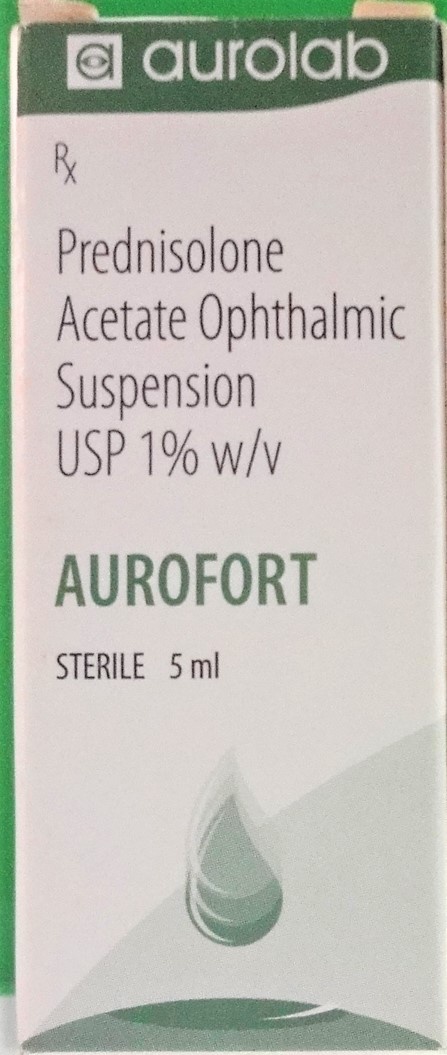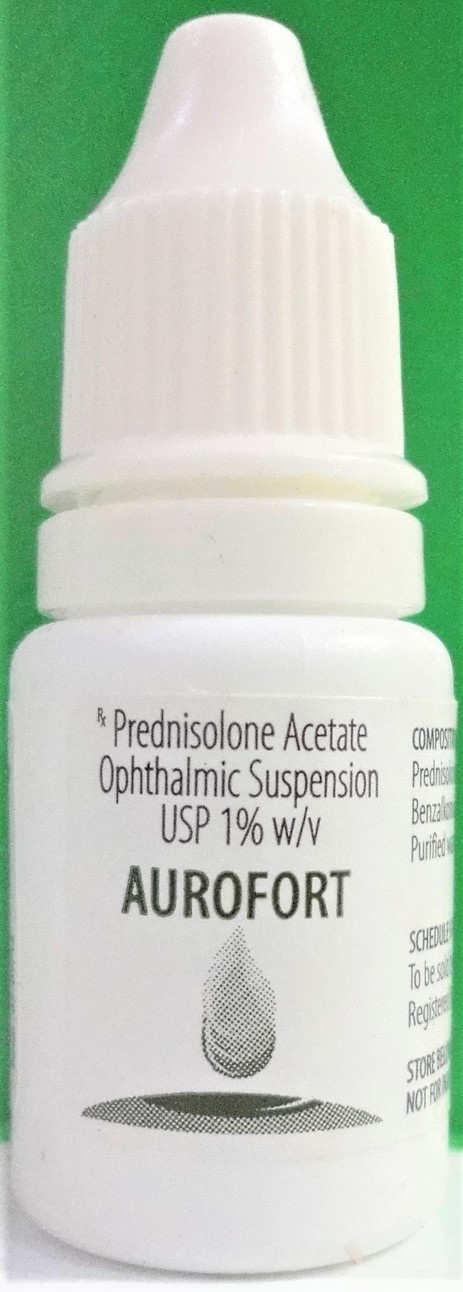AUROFORT Eye drops
ក្រុមហ៊ុនផលិតឱសថ:
Aurolab, India


- សារធាតុសកម្ម
- ប្រសិទ្ធិភាពព្យាបាល និង កម្រិតប្រើប្រាស់
- ហាមប្រើ
- ផលរំខាន
- ស្ត្រីមានផ្ទៃពោះ និង ស្ត្រីបំបៅដោះកូន
- ការប្រុងប្រយ័ត្នជាពិសេស
- សកម្មភាពឱសថ បរិយាយប័ណ្ណឱសថ
-
សារធាតុសកម្ម
-
ប្រសិទ្ធិភាពព្យាបាល និង កម្រិតប្រើប្រាស់
For steroid responsive inflammation of the palpebral and bulbar conjunctive, cornea and anterior segment of the globe.
Dosage and Administration
Instill 1-2 drops into each eye 4 times daily (or) as directed by doctor. Prednisolone acetate is applied topically to the eye in the form of 1% w/v suspension.
-
ហាមប្រើ
1. Acute untreated purulent ocular infections.
2. Acute superficial herpes simplex (dendritic keratitis).
3. Vaccinia
4. Varicella and most other viral diseases of the cornea and conjunctiva.
5. Ocular tuberculosis.
6. Fungal diseases of the eye.
7. Known hypersensitivity to any ingredient in Prednisolone acetate ophthalmic suspension.
8. Soft contact lenses.
9. Glaucoma.
-
ផលរំខាន
Increased intraocular pressure, optic nerve damage, defects in the visual fields. Also posterior subcapsular cataract formation, secondary ocular infections from fungi or viruses liberated from ocular tissues, and perforation of the globe when used in conditions where there is thinning of the cornea or sclera. Systemic side effects may occur with extensive use of steroids.
-
ស្ត្រីមានផ្ទៃពោះ និង ស្ត្រីបំបៅដោះកូន
Safety of intensive or protracted use of topical steroids during pregnancy has not been substantiated. Therefore, Prednisolone acetate ophthalmic suspension should be used during pregnancy only if the potential benefit justifies the potential risk to the foetus.
It is not known whether topical administration of corticosteroids could result in sufficient systemic absorption to produce detectable quantities in human milk. Because of the potential for serious adverse reactions in nursing infants from Prednisolone acetate ophthalmic suspensions, a decision should be made whether to discontinue nursing or to discontinue the medication.
-
ការប្រុងប្រយ័ត្នជាពិសេស
Warnings
1. Not for injection. Do not touch the nozzle tip to any surface, since this may contaminate the solution.
2. In those diseases causing thinning of the cornea, perforation has been reported with the use of topical steroids.
3. Since Prednisolone acetate ophthalmic suspension contains no antimicrobial activity if infection is present appropriate measures must be taken to counteract the organisms involved.
4. Acute purulent infections of the eye may be masked or enhanced by the use of topical steroids.
5. Use of steroid medication in the presence of stromal herpes simplex requires caution and should be followed by frequent mandatory slit-lamp microscopy.
6. As fungal infections of the cornea have been reported coincidentally with long term local steroid applications, fungal invasion may be suspected in any persistent corneal ulceration where a steroid has been used, or is in use.
7. Use of topical corticosteroids may cause increased intraocular pressure in certain individuals. This may result in damage to the optic nerve with defects in the visual fields. It is advisable that the intraocular pressure be checked frequently.
Precautions
Posterior subcapsular cataract formation has been reported after heavy or protracted use of topical ophthalmic corticosteroids. Patients with histories of herpes simplex keratitis should be treated with caution.
-
សកម្មភាពឱសថ
Prednisolone acetate is a glucocorticoid that, on the basis of weight, has 3-5 times the anti-inflammatory potency of hydrocortisone. Glucocorticoids inhibit the edema, fibrin deposition, capillary dilatation and phagocytic migration of the acute inflammatory response as well as capillary proliferation, deposition of collagen and scar formation.
*ព័ត៌មានឱសថត្រូវបានរៀបរៀងដោយ អ៊ីម៉ាតុគឹ មេឌីក (ខេមបូឌា) ដោយផ្អែកលើប្រភពព័ត៌មានខាងក្រោម។ សម្រាប់ព័ត៌មានលម្អិត សូមស្វែងរកនៅក្នុងក្រដាសព័ត៌មាននៃឱសថនីមួយៗ ឬ សាកសួរទៅកាន់ក្រុមហ៊ុនឱសថឬតំណាងចែកចាយនៃឱសថនីមួយៗ។
ប្រភពព័ត៌មាន៖
- ក្រដាសព័ត៌មាននៃឱសថសម្រាប់អ្នកជំនាញវេជ្ជសាស្ត្រដែលប្រើប្រាស់នៅប្រទេសជប៉ុន (Pharmaceutical and Medical Devices Agency, Pmda): https://www.pmda.go.jp
- ព័ត៌មានសង្ខេបនៃឱសថសម្រាប់អ្នកជំងឺដែលប្រើប្រាស់នៅប្រទេសជប៉ុន: http://www.rad-ar.or.jp
